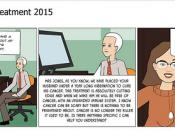1. Cancer is the abnormal uncontrolled growth of cells, which, if left untreated, can ultimately cause death.
2. Malignant tumor (or neoplasm) a tumor that is cancerous and capable of spreading and a benign tumor is a tumor that is not cancerous.
3. The chief risk for lung cancer is tobacco smoke, which accounts for 87% of cancers.
4. The three strategies for lower the risk of colon cancer are to eat food rich in fruits, vegetables, and whole grains; adequate intake of folic acid, calcium, and vitamin D; regular use of nonsteroidal anti-inflammatory drugs such as aspirin.
5. The three-part program for early detection of breast cancer that is recommended by the American Cancer Society is to have a mammogram, which is recommended for women over 40, clinical breast exams, recommended for women ages 20 and 39, and breast self exams, recommended for women 20 and older.
6. Prostate cancer is detected by rectal exams.
7. The ABCD test for melanoma is:
A-Asymmetry: is one half unlike the other?
B-Border irregularity: Does it have an uneven, scalloped edge rather than a clearly defined border?
C-Color variation: Is the color uniform, or does it vary from area to another, from tan to brown to black, or from white to red to blue.
D-Diameter larger than ü inch: At its width point, is the growth as large as, or larger than, a pencil eraser?
8. The primary risk factors for cervical cancer stems sexually transmitted diseases.
9. The precautions a person should take to decrease the risk of skin cancer are to wear long sleeve shirts and long pants, use sunscreen, avoid sun exposure 10a.m. and 4 p.m., and avoid tanning beds.
10. An SPF rating refers to the amount of time you can stay out in the sun before you...


